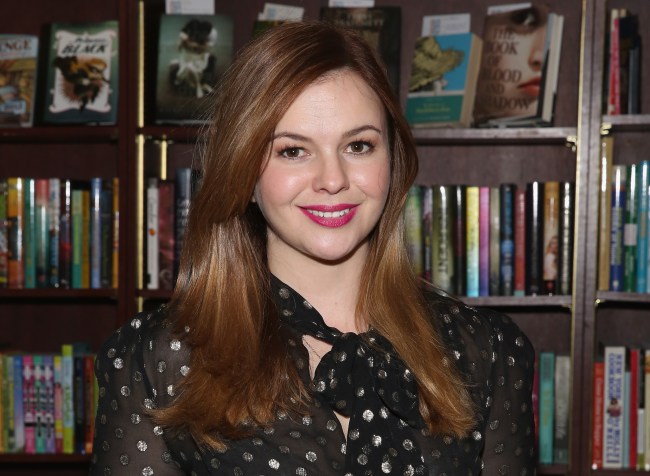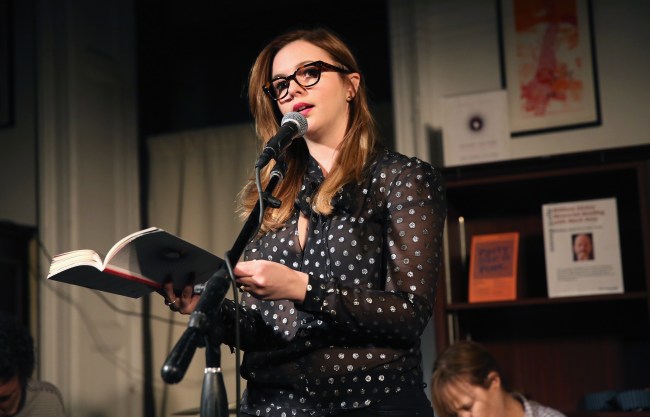
Actress and author Amber Tamblyn released her third book of poetry today. In Dark Sparkler, she tackles the tragic deaths of actresses, including Jayne Mansfield, Sharon Tate, Brittany Murphy, and Lindsay Lohan; there are even a few made-up ones. There’s also commissioned artwork accompanying the poems from director David Lynch and musician Marilyn Manson.
We recently had the chance to speak to Tamblyn about why she chose the actresses she did.
How did Brittany Murphy’s still-recent death affect you?
It was the first time a woman in my age range had died so mysteriously. It was in that shroud of mystery is this false glamorization after her death of immortalizing her and not really talking about anything other than the immortalization: “Oh, she was such an amazing actress,” “she was so beautiful.” I remember this cover of a magazine where they put a picture of her in a sequined dress looking like so amazing. It stunned me. It was the first time that I related to death both as a literal and metaphorical aspect of one’s career.
We react differently to someone dying while we’re alive than to someone who was gone before we were even born, which is why I’m curious about your Sharon Tate poem.
Hers is the most infamous death in that book. I was trying to find a way to tell it and not just to be provocative, but to find a way to be different about it. It struck me that all I’ve been doing is studying the internal lives of women, the internal emotions, the internal grief, the internality of these women. Then I thought, “What if I just wrote a very literal poem about her insides?” That’s what led me to write about her unborn child. If I had written about what was going on outside of her body in that moment, it would be terrible. Nobody wants to read that. There was an innocence in the thought of what the child will never know. I thought for sure David Lynch was going to want to do a painting for that piece, and he very much didn’t. He actually had said to me it was upsetting him and he didn’t understand why the experience needed to be revisited.
Then there’s Marilyn Monroe, of course.
While Sharon Tate is the most infamous death, Marilyn Monroe is the most famous out of all of the women in there. So I thought less is more. In reading her coronary reports, there was something about how her hand was found on her pillow next to her head, and that her hair was wrapped very, very tightly around her index finger, so much so that there was blood circulation cut off in the tip of her finger. When they were formally investigating it, those are things that need to be written down because it could mean, “Was she struggling?” There just could be any kind of detail, as far as was it a homicide or a suicide, or what was it?
Lindsay Lohan is a bit of an outlier, in that she’s still alive. Why include her?
I imagine a lot of people will think it’s my ominous way of saying, “You’re next, girl, you don’t want to end up like these women.” That poem, to me, is my way of saying to her, “I’m not going to write your poem. It’s yours to write and I’m not going to do what everybody does, which is project onto you who you are, how you live, how you’re going to die.” I feel like it’s a safe page for her only, but it’s also a way of saying we’re all going to project onto that page what we feel. That’s what we do with celebrities. We all have a different opinion about who they are, what can happen to them. This is my way of saying that it’s your story still because you are alive. I’m not going to treat you as if you’re dead.
You did a lot of interviews as part of your research. Who did you speak to?
The Lucy Gordon poem is a retelling of her life through what I could find, my research, and a personal story. That poem really represents to me how people project what they think onto a story, “Oh well, she died because of this.” Any time any celebrity dies or had been in rehab or anything, everyone’s saying, “This is probably what happened.” I just took the literal articles that I had read about what they thought her life was like, and I did this weird collage-hybrid between that and this really intense story [friend and former MTV News correspondent Gideon Yago] told me because he had dated her. He knew her very well and she became a good friend. He was very integral to the part of her life up until her suicide.

In the epilogue, you say that you admire the deaths of these actresses. Why admiration?
I started to admire the freedom that death represents and I was admiring these women who had made an impact and come and gone quickly. At that time, I was really struggling with my own thoughts on acting. I’ve been acting since I was 11 years old, had gone from job to job to job to job, and it was taxing. For me, thoughts of death were really beautiful metaphors for thoughts of stopping. Every time I was reading about the end of a life, I was thinking internally about, “Well, I want the end of my life as I know it,” not suicidal thoughts, but just thoughts on stopping, like what that would feel like. Only a couple years ago, there was a sense of wanting to feel like a new leaf was turning and wanting to feel like a shedding of the skin and that things were changing.
I couldn’t describe how or why and maybe I didn’t want to just act anymore. There were just a million questions. It felt right to ask myself if I was allowed to stop acting, if I was allowed to do something else. There was so much of it. The admiration just comes from death as a metaphor. Death as ultimately, [those women] stopped the pain of their lives, they stopped the pain of the positions of their lives. they stopped the pain of being projected onto objects.
That to me was very desirable.
You took a break before finishing the book. How did you know it was time to return?
I have to just embrace death. I’m doing the wrong thing. I’m going against the current. Again, when I say death, that’s death as a metaphor. Me embracing whatever was dying in me was what needed to happen. The ultimate research of all of these women was an accumulation leading to my own exorcism of my own fears about who I am, my own questions and all of that. The more I just embraced it and stopped feeling like I’m going to become them, I’m going to die and all things that were spinning through my head.
Which is where the list [of Tamblyn’s Google searches in the epilogue] came. It was me saying, “Look at this, It’s just a list of names. None of this matters. Everybody has to die.” I was ultimately trying to say how internally, all women are the same, everybody’s suffering, everyone’s in pain, everyone’s in fear, and that was a way of making a very long monotonous list that makes you want to skip through it. It’s so much. The thing that was important all along was staring me right in the face: Yes, I’m exactly like them. I didn’t want to be. I wanted to separate myself. But actually, it was the opposite. My pain is their pain. No matter what you do, the pain is similar and that’s what’s important to remember.
Amber Tamblyn’s Dark Sparkler is out on Harper Perennial today.






